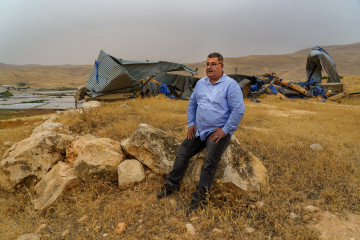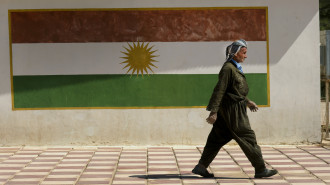

Furush Beit Dajan - The phone in Azem Hajj Mohammed's office hasn't stopped ringing. The head of Furush Beit Dajan council, a village in the northern occupied West Bank, has laboured tirelessly through the night, striving to unveil the identities of two individuals hailing from the nearby village of Jiftlik.
The suspects had allegedly covertly tapped into the water distribution system under the cover of darkness, triggering a hidden water dispute.
As per Ottoman-era legislation, Furush Beit Dajan residents should receive 10% of their water from the northern artesian well, while Jiftlik gets 90%. Yet, during periods of low water pressure, some unsatisfied residents resort to illegal pipe connections, fuelling growing tensions within the community, where agriculture is the main source of income for nine out of ten people.
"Strict Israeli water regulations, worsened by a deep drought in the Jordan Valley, have sparked a grave water crisis, disrupting the village's economy and pushing farmers into intensive cultivation"
"I need to quickly pinpoint the responsible parties and mediate before this theft evolves into a family feud and catches the Israeli military's eye," the mayor told The New Arab during a quick break between calls. "No one's rushing to confess. I'll have to analyse surveillance footage, locate them, and initiate a dialogue," he informs his assistant.
The signs of fatigue, etched in dark circles around his eyes, reflect the strain of overseeing a village trapped in a paradox. Despite resting above the bountiful Eastern aquifer, water trickles in rationed measures.
Strict Israeli water regulations, worsened by a deep drought in the Jordan Valley, have sparked a grave water crisis, disrupting the village’s economy and pushing farmers into intensive cultivation.
Azem Hajj Mohammed's deep concern stems from the fact that access to water guarantees social peace in Furush Beit Dajan.
The village has made a name for itself in the Palestinian agrarian sector, largely thanks to its sprawling lemon orchards, a fruit that eagerly drinks from the water reserves.
"The aroma of lemons wafted through the village like a mist. Water streamed generously, nurturing fields and a mill. The streams ran so vigorously that children ventured close to drowning," recounts 'Abd al-Hamid Abu Firas. The farmer was just nineteen when, in 1967, Israel occupied the West Bank and its water resources after the Six-Day War.
|
|
Since then, water availability has steadily dwindled. In 1993, the Oslo Accords effectively granted Israel control over water management, leading to its current control of 80% of West Bank water reserves.
Today, Israelis, including settlers, average 247 litres of water per day, while their Palestinian neighbours in Area C - under full Israeli military control - have a mere 20 litres, a fifth of the World Health Organisation's minimum recommendation.
Nevertheless, a scarcity of water isn't the only predicament for the village, given the abundance of water resources in the eastern aquifer that lies underneath it. The illegal Israeli settlement of Hamra is located nearby, serving as a stark testament to the unequal allocation of groundwater resources in the occupied West Bank.
Built in 1971 on land seized from Palestinians, Hamra hosts a sprawling 40-hectare date palm plantation. Producing a ton of dates demands a staggering 2,300 cubic meters of water - ten times the quantity needed for a ton of tomatoes.
"I don't see any prospects for improvement in the current status quo, where the Oslo Accords grant Israel control over water"
As groundwater levels decline and the water demands of neighbouring Israeli settlements grow, farmers have been compelled to make a profound choice: forsaking native lemon crops and gradually adopting vertical cultivation and tomato greenhouse farming, which offer a higher productivity-to-water ratio.
On average, 214 cubic meters of water yield a ton of tomatoes, while studies from the Dutch Delft Institute for Water Education reveal that the same amount of lemons requires on average three times more water.
Confronted by these hurdles, the farmers forged ahead, adapting to the circumstances. Consequently, the once-vibrant vista of lemon trees has given way to a striking transformation - the stark white of tomato greenhouses now stands in place of the verdant green. Out of his 450 lemon trees, 50-year-old farmer Rasmi Abu Jeish has maintained just 30, a homage to familial heritage.
"Relying solely on one crop leaves farmers vulnerable to price fluctuations and inclined to resort to pesticides and fertilizers for stable profits. In the long run, this damaging cycle depletes soil fertility and renders it unsuitable for agriculture," explains Muqbel Abu-Jaish of the Palestinian Agriculture Relief Committees, an organisation supporting local farmers in water resource management.
With the citrus trees gone, the village has turned hotter, almost unbearable during the scorching summers when temperatures exceed 40°C in the Jordan Valley. Limited water access coupled with the expansionist policies of Israeli settlements, and worsened by climate change, has shrunk agriculture to a mere 2.6% of the West Bank's GDP.
A study by An-Najah National University reveals a concerning trend of declining annual rainfall in the northern Jordan Valley.
|
|
Analysing climatic data from 1970 to 2019, the study found a reduction of 4.5 mm per decade on an average of 140 mm rainfall per year in this desert drought-prone area, which highlights the slow but increasing impact of climate change on the region’s groundwater recharge, which heavily relies on irrigation. Autumn rainfall is expected to decrease up to 40% in northern and central regions of Israel and the occupied Palestinian territory.
The younger generation of farmers has embraced the shift in production, but it hasn't been smooth sailing. "Even as water dwindled, we decided to stick with farming. The workload has dropped considerably, but there's not much else here for us. It's like life has faded away without water. We have to roll with the punches," explains 25-year-old Saeed Abu Jaish, whose family downsized cultivated land from 15 to two dunams, all converted to greenhouses.
Compounding the difficulties are Israeli restrictions on Palestinians establishing any infrastructure, even rudimentary, for rainwater collection and storage. The entire village falls within Area C, firmly under Israeli administrative and military jurisdiction, effectively barring any agricultural or construction endeavours.
"Traditionally, parents bequeath wealth. We leave barren fields"
In 2021, the mayor successfully erected an agricultural water tank, only for the Israeli military to swiftly dismantle it within hours - a reflection of a recurring pattern, as witnessed in the fate of 270 water installations in Area C over the past five years.
As a result, the local council's hands are tied when it comes to upgrading the water system, which harks back to the days of British rule before 1948. Out of the nine wells that once sustained the village, half have gone bone-dry.
The remaining wells have seen a relentless decrease in their water output, plunging from a generous 2,000 cubic meters an hour before 1967 to a mere 30 cubic meters today, as Mayor Azem Hajj Mohammed explains to The New Arab.
Water restrictions in the occupied West Bank carry another critical, lasting impact. A legislative relic of the Ottoman era, now part of Israeli law, permits labelling fallow Palestinian fields as ‘state land’ if idle for three years.
With water scarcity, rising costs, and Israeli restrictions, farmers abandon land that cannot be irrigated, eroding income and straining family finances. The irrigation of untapped land in Area C has the potential to contribute approximately $704 million to the Palestinian economy, accounting for roughly 7% of GDP.
"I don't see any prospects for improvement in the current status quo, where the Oslo Accords grant Israel control over water. The number of settlers is steadily increasing while the water supply diminishes. Without a change, the situation can only worsen," asserts Issam Khatib, a professor of Water and Environmental Studies at Birzeit University.
|
|
At 63, Adir Abu Anish tends only a sixth of his 50 dunams. Amid the tomato greenhouses, he's ventured into planting vines he expects will fade within years. His once-reliable stream for irrigation now carries contamination from nearby Nablus, prompting legal action from the mayor.
In the shadow of his vineyards, Abu Anish sighs, "Traditionally, parents bequeath wealth. We leave barren fields."
Stefano Lorusso is a multimedia journalist based in Palestine/Israel. His work has appeared on international news outlets such as The Guardian, CGTN, France Télévisions, RSI, Middle East Eye, L'Espresso and Jeune Afrique.
Follow him on Twitter @Stefalorusso and Instagram






 Follow the Middle East's top stories in English at The New Arab on Google News
Follow the Middle East's top stories in English at The New Arab on Google News


